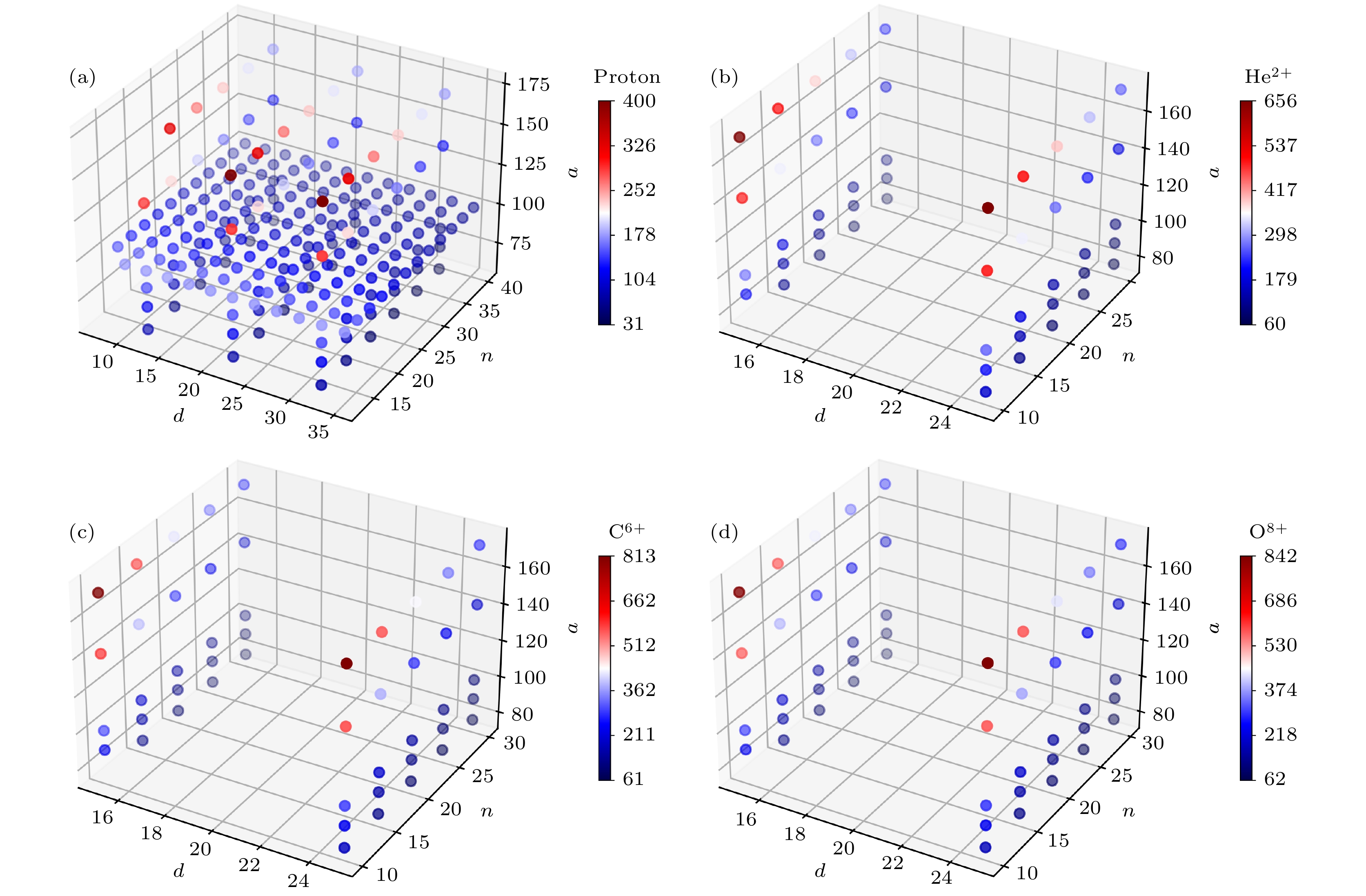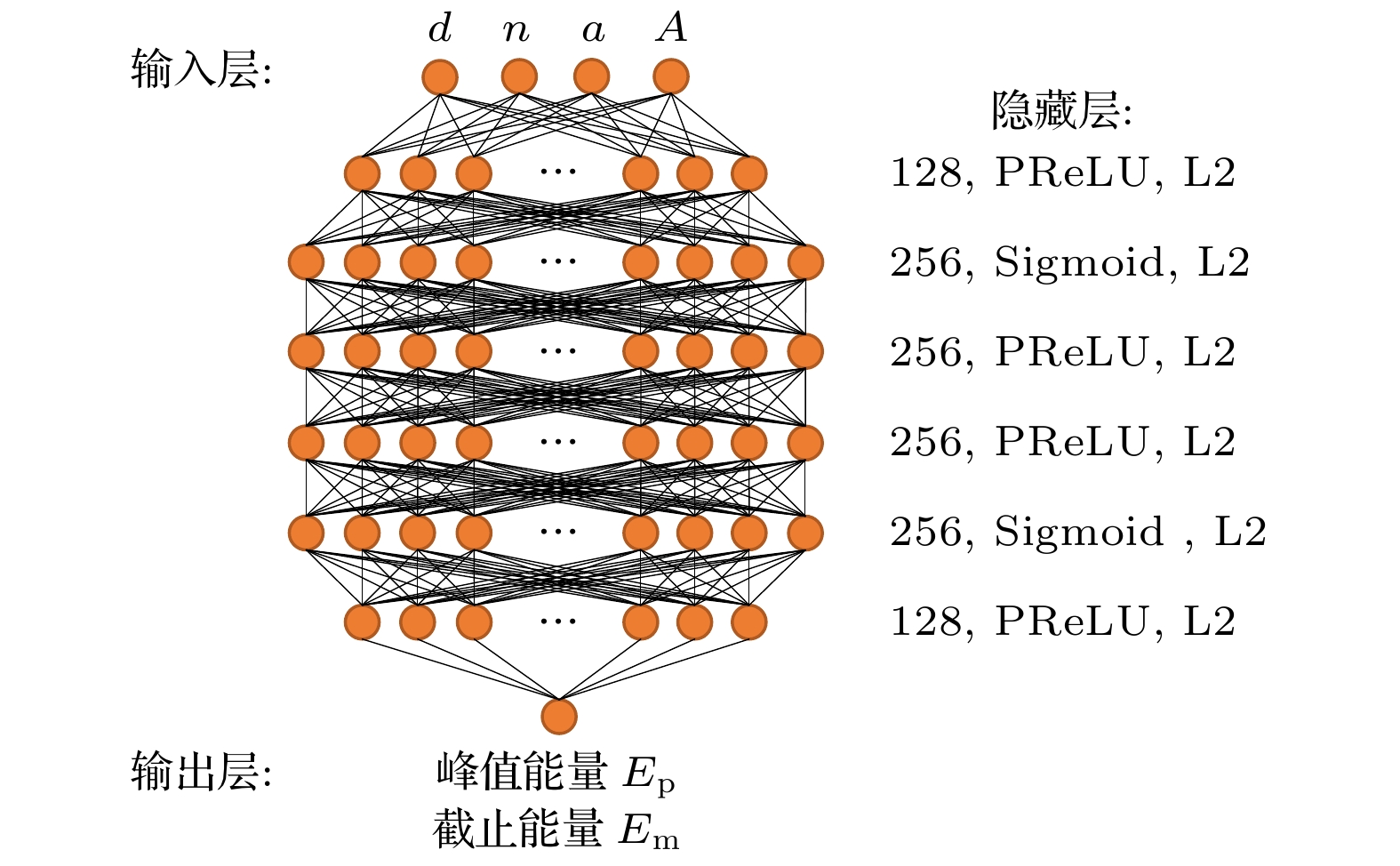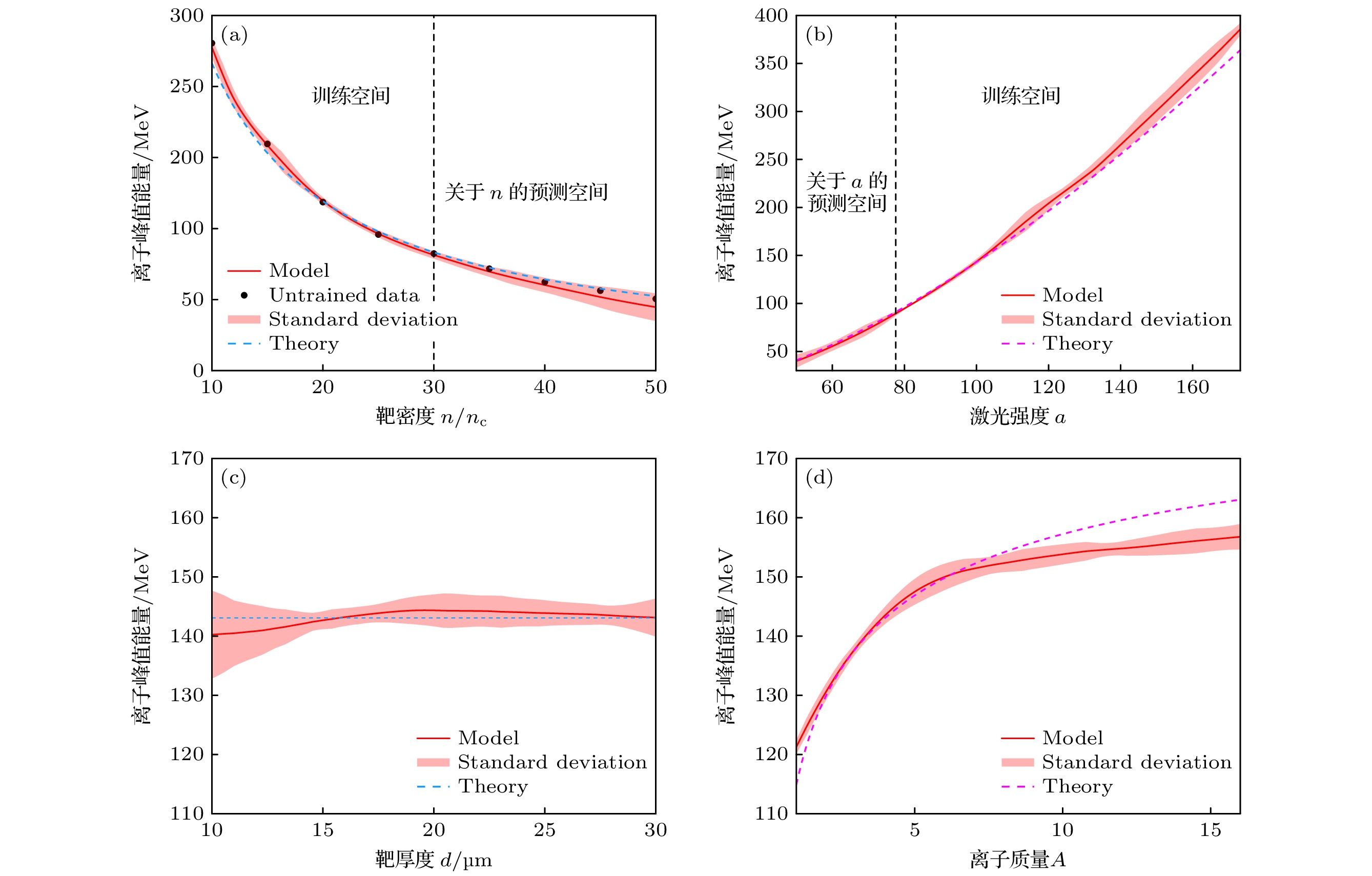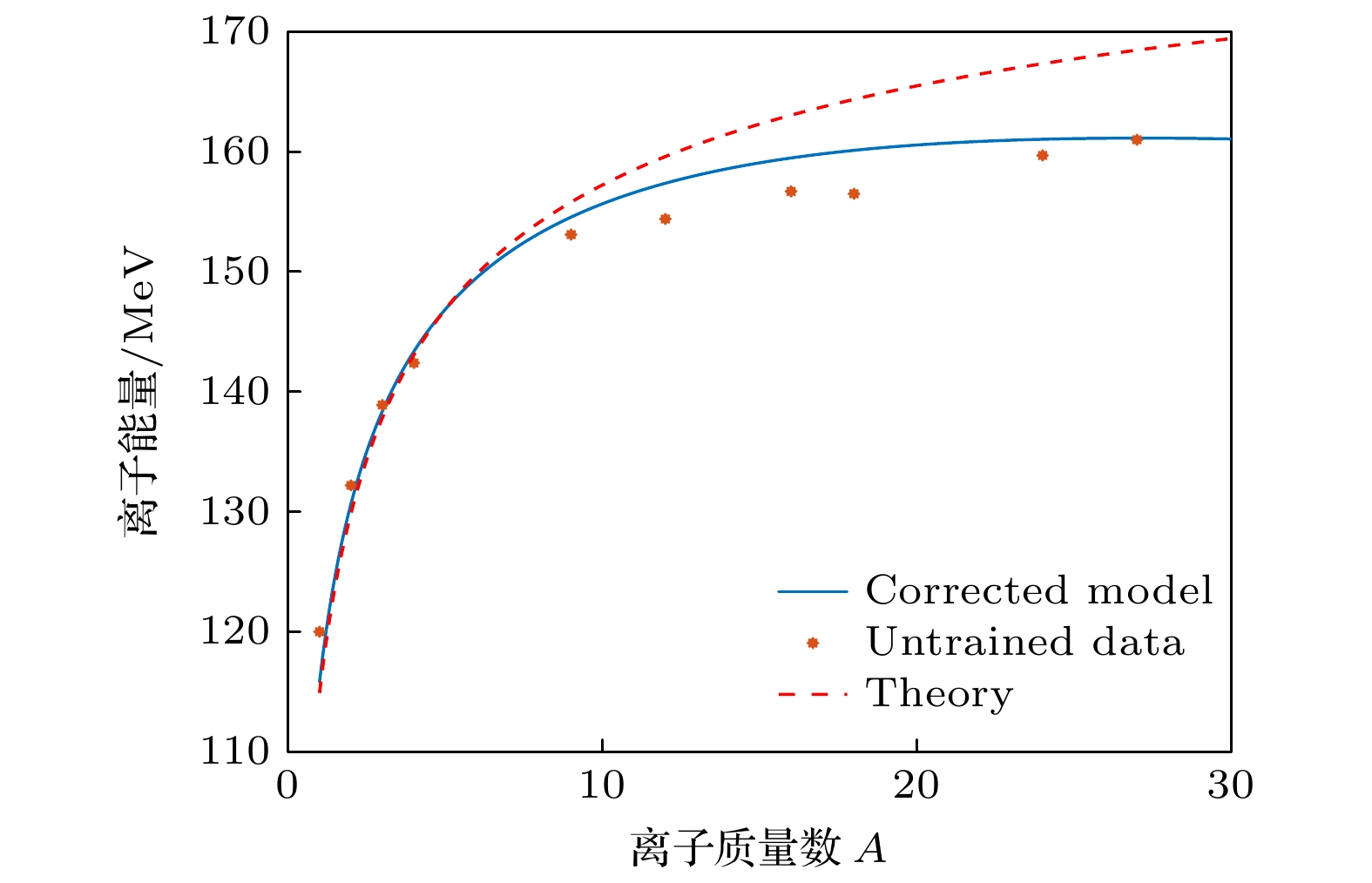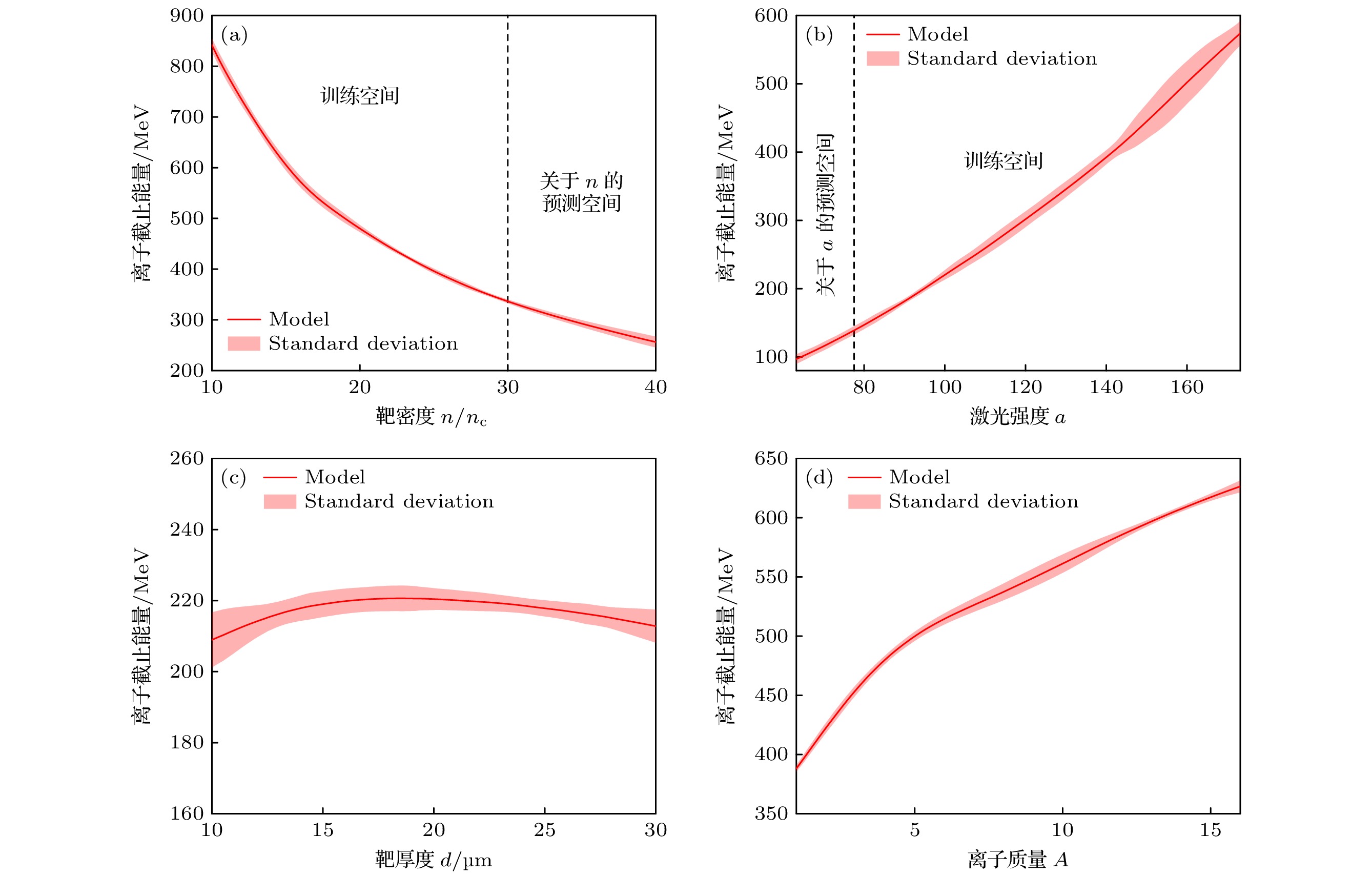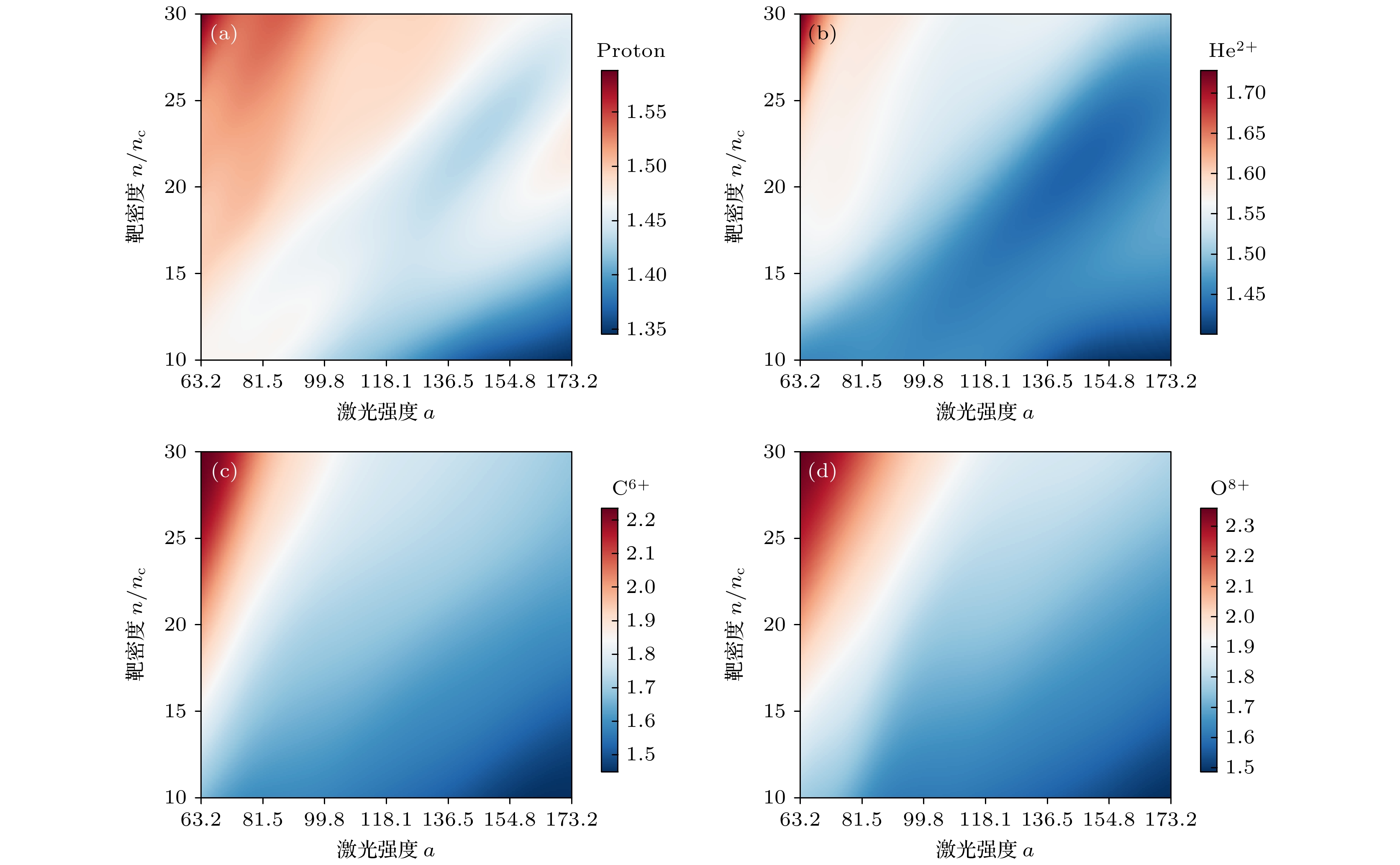-
Laser-driven ion acceleration has potential applications in high energy density matter, ion beam-driven fast ignition, beam target neutron source, warm dense matter heating, etc. Ultrashort relativistic laser interacting with solid target can generate ion beam with several hundreds of MeV in energy, and the quality of the ion beam depends strongly on the interaction parameters between the laser and the target. Development in deep learning can provide new method of analyzing the relationship between parameters in physics system, which can significantly reduce the computational and experimental cost. In this paper, a continuous mapping model of ion peak and cutoff energy is developed based on a fully connected neural network (FCNN). In the model, the dataset is composed of nearly 400 sets of particle simulations of laser-driven solid targets, and the input parameters are laser intensity, target density, target thickness, and ion mass. The model uses sparse parameter values to obtain the analysis results in a large range of parameters, which greatly reduces the computational amount of multi-dimensional parameters sweeping in a wide range. Based on the results of this model mapping, the correction formula for the ion peak energy is obtained. Furthermore, the ratio of ion cutoff energy to peak energy of each set of particle simulation is calculated. Repeating the same training process of ion peak energy and cutoff energy, the continuous mapping model of energy ratio is developed. According to the energy ratio model mapping results, the quantitative description of the relationship between ion cutoff energy and peak energy is realized, and the fitting formula for the cutoff energy of the hole-boring radiation pressure acceleration (HB-RPA) mechanism is obtained, which can provide an important reference for designing the laser-driven ion acceleration experiments.
-
Keywords:
- laser-driven ion acceleration /
- neural Networks
[1] Roth M, Cowan T E, Key M H, et al. 2001 Phys. Rev. Lett. 86 436
 Google Scholar
Google Scholar
[2] Fernandez J C, Honrubia J J, Albright B J, Flippo K A, Gautier D C, Hegelich B M, Schmitt M J, Temporal M, Yin L 2009 Nucl. Fusion 49 065004
 Google Scholar
Google Scholar
[3] Roth M, Jung D, Falk K, et al. 2013 Phys. Rev. Lett. 110 044802.
 Google Scholar
Google Scholar
[4] Jiang X R, Shao F Q, Zou D B, Yu M Y, Hu L X, Guo X Y, Huang T W, Zhang H, Wu S Z, Zhang G B 2020 Nucl. Fusion 60 076019
 Google Scholar
Google Scholar
[5] Patel P K, Mackinnon A J, Key M H, Cowan T E, Foord M E, Allen M, Price D F, Ruhl H, Springer P T, Stephens R 2003 Phys. Rev. Lett. 91 125004
 Google Scholar
Google Scholar
[6] Mancic A, Levy A, Harmand M, Nakatsutsumi M, Antici P, Audebert P, Combis P, Fourmaux S, Mazevet S, Peyrusse O, Recoules V, Renaudin P, Robiche J, Dorchies F, Fuchs J 2010 Phys. Rev. Lett. 104 035002
 Google Scholar
Google Scholar
[7] Pelka A, Gregori G, Gericke D O, et al. 2010 Phys. Rev. Lett. 105 265701
 Google Scholar
Google Scholar
[8] Faenov A Y, Pikuz T A, Fukuda Y, et al. 2009 JETP Lett. 89 485
 Google Scholar
Google Scholar
[9] Faenov A Y, Pikuz T A, Fukuda Y, et al. 2009 Appl. Phys. Lett. 95 101107
 Google Scholar
Google Scholar
[10] Esirkepov T, Borghesi M, Bulanov S V, Mourou G, Tajima T 2004 Phys. Rev. Lett. 92 175003
 Google Scholar
Google Scholar
[11] Pegoraro F, Bulanov S V. 2007 Phys. Rev. Lett. 99 065002
 Google Scholar
Google Scholar
[12] Snavely R A, Key M H, Hatchett S P, et al. 2000 Phys. Rev. Lett. 85 2945
 Google Scholar
Google Scholar
[13] Mackinnon A J, Borghesi M, Hatchett S, KeyM H, Patel P K, Campbell H, Schiavi A, Snavely R, Wilks S C, Willi O 2001 Phys. Rev. Lett. 86 1769
 Google Scholar
Google Scholar
[14] Yin L, Albright B J, Hegelich B M 2006 Laser Part. Beams 24 291
 Google Scholar
Google Scholar
[15] Yin L, Albright B J, Hegelich B M, Bowers K J, Flippo K A, Kwan T J T, Fernández J C 2007 Phys. Plasmas 14 056706
 Google Scholar
Google Scholar
[16] Silva L O, Marti M, Davies J R, Fonseca R A, Ren C, Tsung F S, Mori W B 2004 Phys. Rev. Lett. 92 015002
 Google Scholar
Google Scholar
[17] Chen M, Sheng Z M, Dong Q L, He M, Li Y T, Bari M A, Zhang J 2007 Phys. Plasmas 14 053102
 Google Scholar
Google Scholar
[18] Simmons J F L, Mclnnes C R 1993 Am. J. Phys. 61 205
 Google Scholar
Google Scholar
[19] Macchi A, Veghini S, Pegoraro F 2009 Phys. Rev. Lett. 103 085003
 Google Scholar
Google Scholar
[20] Robinson A P L, Gibbon P, Zepf M, Kar S, Evans R G, Bellei C 2009 Plasma Phys. Controlled Fusion 51 024004
 Google Scholar
Google Scholar
[21] Robinson A P L, Kwon D H, Lancaster K 2009 Plasma. Phys. Controlled Fusion 51 095006
 Google Scholar
Google Scholar
[22] Yan X Q, Lin C, Sheng Z M, Guo Z Y, Liu B C, Lu Y R, Fang Y R, Fang J X 2008 Phys. Rev. Lett. 100 135003
 Google Scholar
Google Scholar
[23] Kar S, Kakolee K F, Qiao B, et al. 2012 Phys. Rev. Lett. 109 185006
 Google Scholar
Google Scholar
[24] Nishiuchi M, Dover N P, Hata M, Sakaki H, Kondo K, Lowe H F, Miyahara T, Kiriyama H, Koga J K, Iwata N, Alkhimova M A, Pirozhkov A S, Faenov A Y, Pikuz T A, Sagisaka A, Watanabe Y, Kando M, Kondo K, Ditter E J, Ettlinger O C, Hicks G S, Najmudin Z, Ziegler T, Zeil K, Schramm U, Sentoku Y 2020 Phys. Rev. Res. 2 033081
 Google Scholar
Google Scholar
[25] LeCun Y, Bengio, Hinton G 2015 Nature 521 436
 Google Scholar
Google Scholar
[26] Abadi M, Agarwal A, Barham P, et al. 2016 arXiv: 1603.04467 [cs.DC
[27] Degrave J, Felici F, Buchli J, et al. 2022 Nature 602 414
 Google Scholar
Google Scholar
[28] Nakhleh J B, Fernadez G M G, Grosskopf M J, Wilson B M, Kline J, Srinivasan G 2021 IEEE Trans. Plasma Sci. 49 2238
 Google Scholar
Google Scholar
[29] Volkova T M, Nerush E N, Kostyukov I Y 2021 Quantum Electron. 51 854
 Google Scholar
Google Scholar
[30] Miyatake T, Shiokawa K, Sakaki H, Dover N P, Nishiuchi M, Lowe H F, Kondo K, Kon A, Kando M, Kondo K, Watanabe Y 2021 Nucl. Instrum. Methods in Phys. Res. Sect. A 999 165227
 Google Scholar
Google Scholar
[31] Emma C, Edelen A, Hogan M J, Shea B O, White G, Yakimenko V 2018 Phys. Rev. Accel. Beams 21 112802
 Google Scholar
Google Scholar
[32] Djordjević B Z, Kemp A J, J Kim 2021 Phys. Plasmas 28 043105
 Google Scholar
Google Scholar
[33] Djordjević B Z, Kemp A J, J Kim Ludwig J, Simpson R A, Wilks S C, Ma T, Mariscal D A 2021 Plasma Phys. Controlled Fusion 63 094005
 Google Scholar
Google Scholar
[34] Qiao B, Zepf M, Borghesi M, Dromey B, Geissler M, Karmakar A, Gibbon P 2010 Phys. Rev. Lett. 105 155002
 Google Scholar
Google Scholar
[35] Arber T D, Bennett K, Brady C S, Lawrence D A, Ramsay M G, Sircombe N J, Gillies P, Evans R G, Schmitz H, Bell A R, Ridgers C P 2015 Plasma Phys. Controlled Fusion 57 113001
 Google Scholar
Google Scholar
[36] Zhou Z H, Wu J X, Tang W 2002 Artif. Intell. 137 239
 Google Scholar
Google Scholar
[37] Robinson A P L 2011 Phys. Plasmas 18 056701
 Google Scholar
Google Scholar
[38] Weng S M, Murakami M, Mulser P, Sheng Z M 2012 New J. Phys. 14 063026
 Google Scholar
Google Scholar
-
图 1 在
$t = 70{T_0}$ 时刻, (a) He2+离子的$x{\text{-}}v$ 相空间分布, (b) He2+离子的能谱分布, (c) C6+离子的$x{\text{-}}v$ 相空间分布, (d) C6+离子的能谱分布. 其中, 激光强度$a = 100$ , 靶密度$n = 25{n_{\text{c}}}$ , 靶厚$d = 25{\lambda _0}$ ; 红色虚线框内为峰值能量所对应的离子, 蓝色虚线框内为截止能量所对应的离子Fig. 1. At
$t = 70{T_0}$ , (a) the$x{\text{-}}v$ phase space diagram of He2+, (b) the energy spectrum of He2+, (c) the$x{\text{-}}v$ phase space diagram of C6+, (d) the energy spectrum of C6+, with$ d = 25{\lambda _0} $ ,$n = 25{n_{\text{c}}}$ and$a = 100$ . The red dashed box circles the ions with peak energy, and the blue dashed box circles the ions with cutoff energy.图 4 He2+离子 (a) 峰值能量
${E_{\text{p}}}$ 与 (b) 截止能量${E_{\text{m}}}$ 的二维连续映射图, 其中靶厚$d = 15{\lambda _0}$ , 参数映射范围为$63.2 \leqslant a \leqslant 173.2$ 和$10{n_{\text{c}}} \leqslant n \leqslant 40{n_{\text{c}}}$ Fig. 4. Two-dimensional continuous mapping of peak energy
${E_{\text{p}}}$ (a) and cutoff energy${E_{\text{m}}}$ (b) for He2+ over$63.2 \leqslant a \leqslant 173.2$ and$10{n_{\text{c}}} \leqslant n \leqslant 40{n_{\text{c}}}$ with$d = 15{\lambda _0}$ .图 5 (a) He2+离子峰值能量
${E_{\text{p}}}$ 关于靶密度$n$ 的映射曲线, 其中靶厚$d = 15{\lambda _0}$ , 激光强度$a = 100$ ; (b) He2+离子峰值能量${E_{\text{p}}}$ 关于激光强度$a$ 的映射曲线, 其中靶厚$d = 15{\lambda _0}$ , 靶密度$n = 20{n_{\text{c}}}$ ; (c) He2+离子峰值能量${E_{\text{p}}}$ 关于靶厚$d$ 的映射曲线, 其中靶密度$n = 20{n_{\text{c}}}$ , 激光强度$a = 100$ ; (d)离子峰值能量${E_{\text{p}}}$ 关于离子质量数$A$ 的映射曲线, 其中靶厚$d = 15{\lambda _0}$ , 靶密度$n = 20{n_{\text{c}}}$ , 激光强度$a = 100$ . 图中红色实线为代理模型的映射曲线, 模型标准差用红色色块填充于代理模型曲线两侧. 蓝色虚线给出的是根据HB-RPA机制理论公式所绘出的离子峰值能量随离子密度变化的曲线, 黑色实心数据点为测试集数据点, 参数取值范围与模型预测范围用黑色虚线分隔Fig. 5. (a) Parameter scan of He2+ peak energy
${E_{\text{p}}}$ over target density$n$ with$d = 15{\lambda _0}$ ,$a = 100$ ; (b) parameter scan of He2+ peak energy${E_{\text{p}}}$ over laser intensity$a$ with$d = 15{\lambda _0}$ ,$n = 20{n_{\text{c}}}$ ; (c) parameter scan of He2+ peak energy${E_{\text{p}}}$ over target thickness$d$ with$a = 100$ ,$n = 20{n_{\text{c}}}$ ; (d) parameter scan of ion peak energy${E_{\text{p}}}$ over ion mass number$A$ with$a = 100$ ,$n = 20{n_{\text{c}}}$ and$d = 15{\lambda _0}$ . The SE mapping curves are drawn with red solid, the theoretical curves are drawn with dashed, the red filled region indicates the standard deviation, and the untrained data from test subset are drawn with black dot.图 7 (a) He2+离子截止能量
${E_{\text{m}}}$ 关于靶密度$n$ 的映射曲线, 其中靶厚$d = 15{\lambda _0}$ , 激光强度$a = 100$ ; (b) He2+离子截止能量${E_{\text{m}}}$ 关于激光强度$a$ 的映射曲线, 其中靶厚$d = 15{\lambda _0}$ , 靶密度$n = 20{n_{\text{c}}}$ ; (c) He2+离子截止能量${E_{\text{m}}}$ 关于靶厚$d$ 的映射曲线, 其中靶密度$n = 20{n_{\text{c}}}$ , 激光强度$a = 100$ ; (d) 离子截止能量${E_{\text{m}}}$ 关于离子质量数$A$ 的映射曲线, 其中靶厚$d = 15{\lambda _0}$ , 靶密度$n = 20{n_{\text{c}}}$ , 激光强度$a = 100$ Fig. 7. (a) Parameter scan of He2+ cutoff energy
${E_{\text{m}}}$ over target density$n$ with$d = 15{\lambda _0}$ ,$a = 100$ ; (b) parameter scan of He2+ cutoff energy${E_{\text{m}}}$ over laser intensity$a$ with$d = 15{\lambda _0}$ ,$n = 20{n_{\text{c}}}$ ; (c) parameter scan of He2+ cutoff energy${E_{\text{m}}}$ over target thickness$d$ with$a = 100$ ,$n = 20{n_{\text{c}}}$ ; (d) parameter scan of ion cutoff energy${E_{\text{m}}}$ over ion mass number$A$ with$a = 100$ ,$n = 20{n_{\text{c}}}$ and$d = 15{\lambda _0}$ .图 8 (a) 质子, (b) He2+, (c) C6+和 (d) O8+的能量比值
$k = {E_{\text{m}}}/{E_{\text{p}}}$ 的二维连续映射图, 其中靶厚$d = 20{\lambda _0}$ , 参数映射范围为$63.2 \leqslant a \leqslant 173.2$ 和$10{n_{\text{c}}} \leqslant n \leqslant 30{n_{\text{c}}}$ Fig. 8. Two-dimensional continuous mapping of
$k = {E_{\text{m}}}/{E_{\text{p}}}$ over$63.2 \leqslant a \leqslant 173.2$ and$10{n_{\text{c}}} \leqslant n \leqslant 30{n_{\text{c}}}$ with$d = 20{\lambda _0}$ : (a) Proton case; (b) He2+; (c) C6+; (d) O8+.图 9 C6+离子能量比值
$k$ 随(a)激光强度和(b)靶密度的映射曲线(实线)和拟合公式结果(虚线), 其中参数范围分别为$63.2 \leqslant a \leqslant 173.2$ ,$10{n_{\text{c}}} \leqslant n \leqslant 30{n_{\text{c}}}$ , 靶厚$d = 15{\lambda _0}$ Fig. 9. Parameter scan (solid) and fitted formula (dashed) of k over (a)
$63.2 \leqslant a \leqslant 173.2$ and (b)$10{n_{\text{c}}} \leqslant n \leqslant 30{n_{\text{c}}}$ for C6+ with$d = 15{\lambda _0}$ .表 1 数值模拟数据集参数取值分布
Table 1. Simulation datasets prepared for neural network training.
离子种类 模拟组数 $d/{\lambda _0}$ $n/{n_{\text{c}}}$ $a$ Proton 231 [7.5, 35] [12.5, 40] [63.2, 173.2] He2+ 49 15, 25 [10, 30] [77.5, 173.2] C6+ 50 15, 25 [10, 30] [77.5, 173.2] O8+ 50 15, 25 [10, 30] [77.5, 173.2] 其他 20 独立分布 -
[1] Roth M, Cowan T E, Key M H, et al. 2001 Phys. Rev. Lett. 86 436
 Google Scholar
Google Scholar
[2] Fernandez J C, Honrubia J J, Albright B J, Flippo K A, Gautier D C, Hegelich B M, Schmitt M J, Temporal M, Yin L 2009 Nucl. Fusion 49 065004
 Google Scholar
Google Scholar
[3] Roth M, Jung D, Falk K, et al. 2013 Phys. Rev. Lett. 110 044802.
 Google Scholar
Google Scholar
[4] Jiang X R, Shao F Q, Zou D B, Yu M Y, Hu L X, Guo X Y, Huang T W, Zhang H, Wu S Z, Zhang G B 2020 Nucl. Fusion 60 076019
 Google Scholar
Google Scholar
[5] Patel P K, Mackinnon A J, Key M H, Cowan T E, Foord M E, Allen M, Price D F, Ruhl H, Springer P T, Stephens R 2003 Phys. Rev. Lett. 91 125004
 Google Scholar
Google Scholar
[6] Mancic A, Levy A, Harmand M, Nakatsutsumi M, Antici P, Audebert P, Combis P, Fourmaux S, Mazevet S, Peyrusse O, Recoules V, Renaudin P, Robiche J, Dorchies F, Fuchs J 2010 Phys. Rev. Lett. 104 035002
 Google Scholar
Google Scholar
[7] Pelka A, Gregori G, Gericke D O, et al. 2010 Phys. Rev. Lett. 105 265701
 Google Scholar
Google Scholar
[8] Faenov A Y, Pikuz T A, Fukuda Y, et al. 2009 JETP Lett. 89 485
 Google Scholar
Google Scholar
[9] Faenov A Y, Pikuz T A, Fukuda Y, et al. 2009 Appl. Phys. Lett. 95 101107
 Google Scholar
Google Scholar
[10] Esirkepov T, Borghesi M, Bulanov S V, Mourou G, Tajima T 2004 Phys. Rev. Lett. 92 175003
 Google Scholar
Google Scholar
[11] Pegoraro F, Bulanov S V. 2007 Phys. Rev. Lett. 99 065002
 Google Scholar
Google Scholar
[12] Snavely R A, Key M H, Hatchett S P, et al. 2000 Phys. Rev. Lett. 85 2945
 Google Scholar
Google Scholar
[13] Mackinnon A J, Borghesi M, Hatchett S, KeyM H, Patel P K, Campbell H, Schiavi A, Snavely R, Wilks S C, Willi O 2001 Phys. Rev. Lett. 86 1769
 Google Scholar
Google Scholar
[14] Yin L, Albright B J, Hegelich B M 2006 Laser Part. Beams 24 291
 Google Scholar
Google Scholar
[15] Yin L, Albright B J, Hegelich B M, Bowers K J, Flippo K A, Kwan T J T, Fernández J C 2007 Phys. Plasmas 14 056706
 Google Scholar
Google Scholar
[16] Silva L O, Marti M, Davies J R, Fonseca R A, Ren C, Tsung F S, Mori W B 2004 Phys. Rev. Lett. 92 015002
 Google Scholar
Google Scholar
[17] Chen M, Sheng Z M, Dong Q L, He M, Li Y T, Bari M A, Zhang J 2007 Phys. Plasmas 14 053102
 Google Scholar
Google Scholar
[18] Simmons J F L, Mclnnes C R 1993 Am. J. Phys. 61 205
 Google Scholar
Google Scholar
[19] Macchi A, Veghini S, Pegoraro F 2009 Phys. Rev. Lett. 103 085003
 Google Scholar
Google Scholar
[20] Robinson A P L, Gibbon P, Zepf M, Kar S, Evans R G, Bellei C 2009 Plasma Phys. Controlled Fusion 51 024004
 Google Scholar
Google Scholar
[21] Robinson A P L, Kwon D H, Lancaster K 2009 Plasma. Phys. Controlled Fusion 51 095006
 Google Scholar
Google Scholar
[22] Yan X Q, Lin C, Sheng Z M, Guo Z Y, Liu B C, Lu Y R, Fang Y R, Fang J X 2008 Phys. Rev. Lett. 100 135003
 Google Scholar
Google Scholar
[23] Kar S, Kakolee K F, Qiao B, et al. 2012 Phys. Rev. Lett. 109 185006
 Google Scholar
Google Scholar
[24] Nishiuchi M, Dover N P, Hata M, Sakaki H, Kondo K, Lowe H F, Miyahara T, Kiriyama H, Koga J K, Iwata N, Alkhimova M A, Pirozhkov A S, Faenov A Y, Pikuz T A, Sagisaka A, Watanabe Y, Kando M, Kondo K, Ditter E J, Ettlinger O C, Hicks G S, Najmudin Z, Ziegler T, Zeil K, Schramm U, Sentoku Y 2020 Phys. Rev. Res. 2 033081
 Google Scholar
Google Scholar
[25] LeCun Y, Bengio, Hinton G 2015 Nature 521 436
 Google Scholar
Google Scholar
[26] Abadi M, Agarwal A, Barham P, et al. 2016 arXiv: 1603.04467 [cs.DC
[27] Degrave J, Felici F, Buchli J, et al. 2022 Nature 602 414
 Google Scholar
Google Scholar
[28] Nakhleh J B, Fernadez G M G, Grosskopf M J, Wilson B M, Kline J, Srinivasan G 2021 IEEE Trans. Plasma Sci. 49 2238
 Google Scholar
Google Scholar
[29] Volkova T M, Nerush E N, Kostyukov I Y 2021 Quantum Electron. 51 854
 Google Scholar
Google Scholar
[30] Miyatake T, Shiokawa K, Sakaki H, Dover N P, Nishiuchi M, Lowe H F, Kondo K, Kon A, Kando M, Kondo K, Watanabe Y 2021 Nucl. Instrum. Methods in Phys. Res. Sect. A 999 165227
 Google Scholar
Google Scholar
[31] Emma C, Edelen A, Hogan M J, Shea B O, White G, Yakimenko V 2018 Phys. Rev. Accel. Beams 21 112802
 Google Scholar
Google Scholar
[32] Djordjević B Z, Kemp A J, J Kim 2021 Phys. Plasmas 28 043105
 Google Scholar
Google Scholar
[33] Djordjević B Z, Kemp A J, J Kim Ludwig J, Simpson R A, Wilks S C, Ma T, Mariscal D A 2021 Plasma Phys. Controlled Fusion 63 094005
 Google Scholar
Google Scholar
[34] Qiao B, Zepf M, Borghesi M, Dromey B, Geissler M, Karmakar A, Gibbon P 2010 Phys. Rev. Lett. 105 155002
 Google Scholar
Google Scholar
[35] Arber T D, Bennett K, Brady C S, Lawrence D A, Ramsay M G, Sircombe N J, Gillies P, Evans R G, Schmitz H, Bell A R, Ridgers C P 2015 Plasma Phys. Controlled Fusion 57 113001
 Google Scholar
Google Scholar
[36] Zhou Z H, Wu J X, Tang W 2002 Artif. Intell. 137 239
 Google Scholar
Google Scholar
[37] Robinson A P L 2011 Phys. Plasmas 18 056701
 Google Scholar
Google Scholar
[38] Weng S M, Murakami M, Mulser P, Sheng Z M 2012 New J. Phys. 14 063026
 Google Scholar
Google Scholar
计量
- 文章访问数: 5942
- PDF下载量: 120
- 被引次数: 0













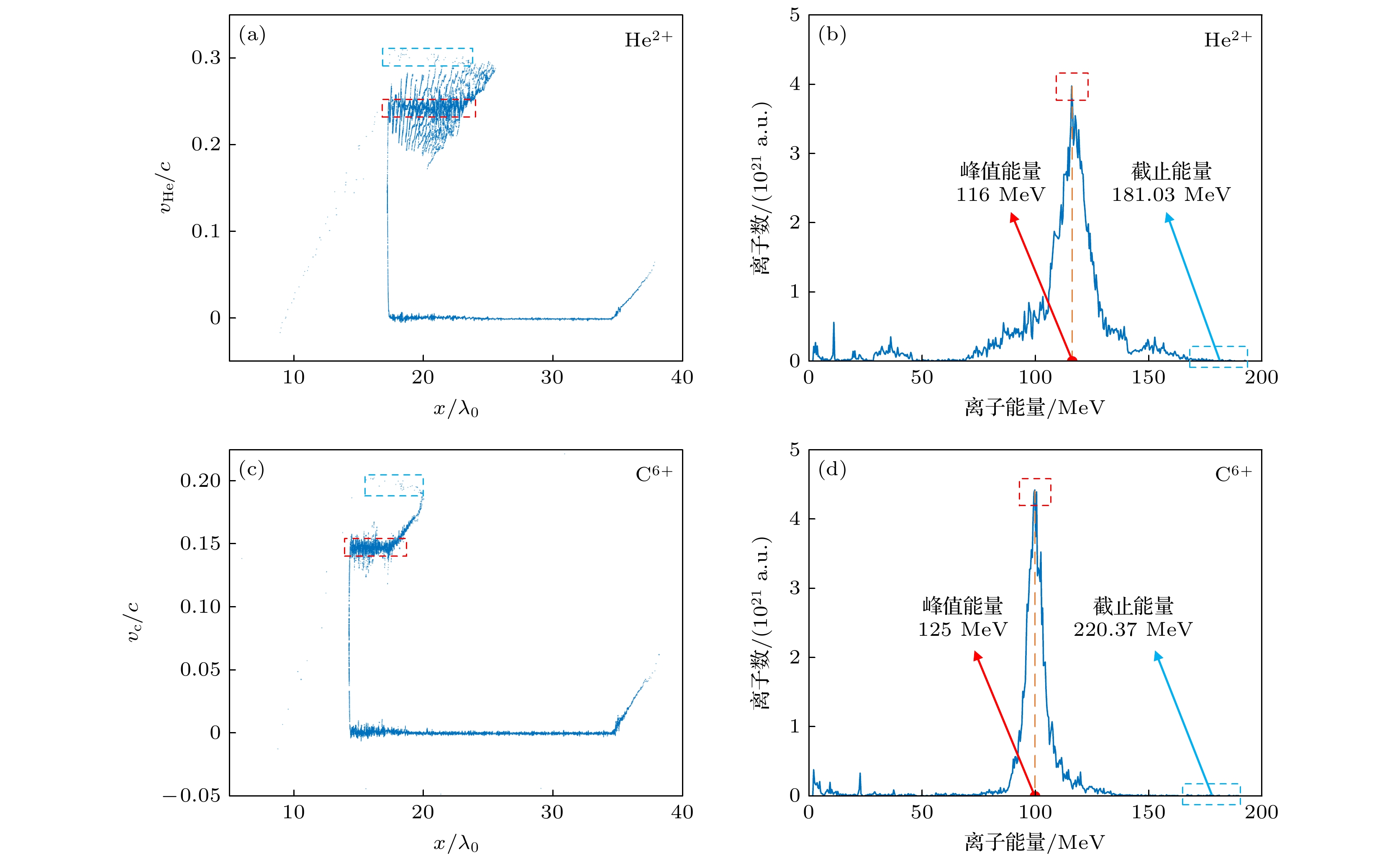












 下载:
下载:
